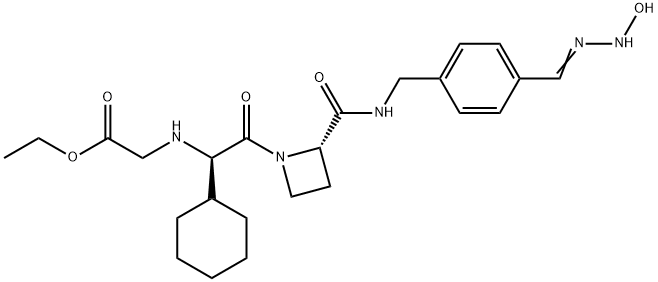- Ximelagatran
-

- $36.00 / 1mg
-
2024-11-19
- CAS:192939-46-1
- Min. Order:
- Purity: 98.09%
- Supply Ability: 10g
|
| Product Name: | EXANTA | | Synonyms: | N-[(1R)-1-Cyclohexyl-2-[(2S)-2-[[[[4-[(hydroxyamino)iminomethyl]phenyl]methyl]amino]carbonyl]-1-azetidinyl]-2-oxoethyl]glycine Ethyl Ester;EXANTA;Glycine, N-[(1R)-1-cyclohexyl-2-[(2S)-2-[[[[4-[(hydroxyaMino)iMinoMethyl]phenyl]Methyl]aMino]carbonyl]-1-azetidinyl]-2-oxoethyl]-, ethyl ester;Exanta (XiMelagatran);Ethyl 2-[[(1R)-1-Cyclohexyl-2-[(2S)-2-[[4-(N'-Hydroxycarbamimidoyl)Phenyl]Methylcarbamoyl]Azetidin-1-Yl]-2-Oxoethyl]Amino]Acetate Ximelagatran;Ethyl 2-[[(1R)-1-Cyclohexyl-2-[(2S)-2-[[4-(N'-Hydroxycarbamimidoyl)Phenyl]Methylcarbamoyl]Azetidin-1-Yl]-2-Oxoethyl]Amino]Acetate
Ethyl 2-[[(1R)-1-Cyclohexyl-2-[(2S)-2-[[4-(N'-Hydroxycarbamimidoyl)Phenyl]Methylcarbamoyl]Azetidin-1-Yl]-2-Oxo-Ethyl;XIMELEGATRAN;EXANTA/XIMELEGATRAN | | CAS: | 192939-46-1 | | MF: | C24H35N5O5 | | MW: | 473.57 | | EINECS: | | | Product Categories: | Aromatics;Chiral Reagents;Intermediates & Fine Chemicals;Pharmaceuticals;Aromatics Compounds | | Mol File: | 192939-46-1.mol |  |
| | EXANTA Chemical Properties |
| Melting point | 65-68?C | | density | 1.35±0.1 g/cm3(Predicted) | | storage temp. | -20°C | | solubility | DMSO : 250 mg/mL (527.91 mM; Need ultrasonic)Methanol : 62.5 mg/mL (131.98 mM; Need ultrasonic) | | pka | 6.87±0.69(Predicted) | | form | powder | | color | white to beige | | Stability: | Hygroscopic |
| | EXANTA Usage And Synthesis |
| Description | Ximelagatran, a prodrug of melagatran with improved oral bioavailability, is a
direct thrombin inhibitor that was launched for the prevention of venous thromboembolic
events (VTE) in elective hip or knee replacement surgery in Germany with
several European countries following with approval for the same indication.
A mutual recognition European filing was subsequently submitted for the prevention
of stroke and other thromboembolic complications associated with atrial
fibrillation (AF). While studies indicate that ximelagatran is as effective as traditional
therapies for preventing strokes and recurring blood clots, the U.S. Food and
Drug Administration has currently declined approval due to potential hepatotoxicity.
Elevation of alanine aminotransferase (three times the upper limit of normal)
has been observed in the first four months of therapy, but levels regress to normal
upon discontinuation of the drug. Despite the questions surrounding the toxicological
consequences of this elevated liver enzyme, ximelagatran remains an attractive
alternative to the current antithrombotic therapies that utilize either the low
molecular weight heparin (LMWH) or warfarin. Since LMWH is administered
subcutaneously once or twice daily, the oral agent ximelagatran is preferable for
patient compliance. In addition to the convenience of oral therapy, ximelagatran
does not require the frequent laboratory monitoring and dosage adjustment that is
necessary with warfarin treatment. A clinical study comparing the efficacy of a fixed
dose (36 mg b.i.d.) of ximelagatran with adjusted dose warfarin for stroke prevention
in patients with nonvalvular atrial fibrillation concluded that ximelagatran
is not inferior to warfarin, and major bleeding occurred at rates similar to warfarin.
The synthesis route to ximelagatran involves the coupling of the three major
components, cyclohexylglycine, azetidine-2-carboxylic acid, and protected p-amidinobenzylamine, using solution-phase peptide chemistry. Subsequent alkylation
of the N-terminus with ethyl bromoacetate, followed by deprotection of
the amidine group and conversion to hydroxyamidine affords the double prodrug
of melagatran. Delivery as ximelagatran provides reproducible oral bioavailability
(18–25%), as measured by concentrations of the active metabolite melagatran
formed by hydrolysis of the ethyl ester and dehydroxylation of the amidine. Melagatran
reversibly binds to the arginine side pocket of both free and clot-bound
thrombin (Ki=2 nM). Inhibition of thrombin ultimately blocks the conversion of
fibrinogen to fibrin, the final step of the coagulation process. A linear relationship
between ximelagatran dose and melagatran concentration exists with peak concentrations
observed two to three hours post dose. Renal excretion is the primary
route of elimination of melagatran (80%) with a half-life of 3–5 hours. Furthermore,
the pharmacokinetics of ximelagatran is not influenced by the type of
thromboembolic disease, obesity, ethnicity, gender, or age. In addition to the typical
contraindications of current antithrombotic therapies, the increase in the liver
enzyme alanine aminotransferase suggests that ximelagatran should not be used in
patients with creatine clearance <30 mL/min. pending further study in this population.
While ximelagatran does not appear to have any interactions with the
cytochrome P-450 system, combination with aspirin has been shown to increase
adverse bleeding. | | Description | Ximelagatran is an ester prodrug of melagatran, a potent, direct, and reversible thrombin inhibitor (Ki = 1.2 nM). While melagatran has poor oral bioavailability, ximelagatran displays good bioavailability resulting, in part, from rapid absorption at the gastrointestinal tract, as well as rapid onset of action. Ximelagatran is converted to melagatran by reduction and hydrolysis at the liver and other tissues. It is used as an anticoagulant in a variety of situations, including thromboembolic disorders, stroke prevention in atrial fibrillation, and therapy in vein thrombosis. | | Chemical Properties | Off-White Amorphous Solid | | Originator | AstraZeneca (Germany) | | Uses | An orally active direct thrombin inhibitor; prodrug of Melagatran. Antithrombotic. | | Definition | ChEBI: A member of the class of azetidines that is melagatran in which the carboxylic acid group has been converted to the corresponding ethyl ester and in which the amidine group has been converted to the corresponding amidoxime. A prodrug for melagatran, ximela
atran was the first orally available direct thrombin inhibitor to be brought to market as an anticoagulant, but was withdrawn in 2006 following reports of it causing liver damage. | | Brand name | Exanta (proposed) (AstraZeneca). | | Biochem/physiol Actions | Ximelagatran is orally active, selective and potent direct thrombin inhibitor. Ximelagatran is a prodrug of thrombin inhibitor melagatran. |
| | EXANTA Preparation Products And Raw materials |
|